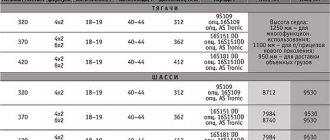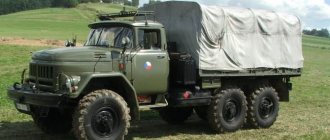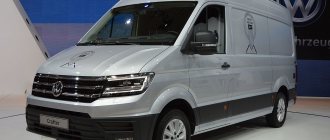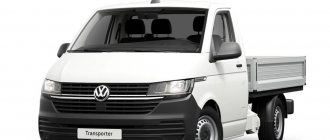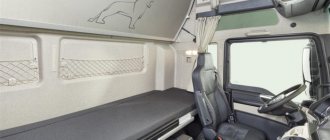Renault Premium is a Renault truck that has a large number of modifications that differ in body type and load capacity. Production of the 1st generation Renault Premium began in 1996. The ideological predecessor of this truck is the Renault Manager model, as well as its related Renault Major configuration. Among the closest opponents of Renault Premium are DAF 95, DAF XF, Iveco Eurostar, Scania P-Series, Volvo FM and others.
The carrying capacity of the 1st generation Renault Premium ranges from 18-26 tons. The car received 60 modifications, as well as several wheel configurations - from 4x2 to 8x4. With the exception of carrying capacity and wheel arrangement, all modifications have a specific type of purpose.
Since 2006, the second generation Renault Premium has been rolling off the assembly line.
How to reduce fuel consumption - 10 TIPS
We are talking about principles that excessively increase fuel consumption during operation.
- A dirty air filter impairs the performance of the air supplied to the engine. Naturally, this affects the parameters of the fuel mixture. Such a violation can significantly increase consumption and reduce power. Don't delay replacing the filter.
- A dirty oil filter similarly complicates the operation of the internal combustion engine.
- Insufficient tire pressure will require more fuel. The rolling gets worse. Check your tire pressure regularly.
- Warming up the engine before driving provides minor fuel savings.
- Low quality gasoline, we are talking not only about consumption, but also about additional harmful effects on individual engine components.
- Impaired wheel alignment and camber acts similarly to tires with insufficient pressure, and rolling resistance increases.
- Electric consumers influence fuel consumption. The air conditioner produces the highest consumption.
- Car load. Empty the trunk of “useful” and “necessary” things; at short intervals the difference will not be noticeable, but over the course of a year you will save a dozen or so liters.
- Keep the revs low according to the transmission capabilities
- Air resistance at high speeds; the higher the speed, the more the oncoming air masses hinder the movement of the car.
Renault Premium real fuel consumption per 100 km: reviews
- Arthur, Arzamas. The odometer of my Renault Premium shows 180 thousand kilometers, the car is still in its prime, so to speak. Its carrying capacity can exceed 20 tons, and the level of fuel consumption reaches 30-40 liters, depending on the load. I have a Business 400, a 2003 car. With an automatic transmission and full power accessories. We were pleased with the visibility and brakes.
- Ilya, Yakutsk. Renault Master is a current hard worker. 1st generation truck, 1999, with 1 million kilometers on the odometer. Still on the move. We repair the car in our own service, which is provided by our freight transport company. There are all consumables and parts - indeed, used ones. A car with a diesel engine and an automatic transmission is quiet and balanced. Consumption is around 35 liters per hundred kilometers.
- Anatoly, Tyumen. Renault Business drives adequately on the highway, as well as on rough city roads. The energy-intensive chassis is designed for any road, including rough terrain. A car with 400 hp. power unit, model Renault 400. In the city the car consumes 40 liters.
- Marat, Tver region. I have a Renault Business hitch. A vehicle with a carrying capacity of 20 tons. Power unit 3700DCI with Euro 3, fuel consumption at 35-40 liters depending on the number of accelerations. It's much more practical to drive on the highway because I'm driving at one speed. In the current case, it manages to fit into 30 liters, no more. The car is pleasant and has an energy-intensive chassis, but the interior is quite noisy. A car with an automatic transmission that changes gears dynamically.
- Ilya, Orsk. I’m a truck driver, I’ve been driving a 385-horsepower Renault Premium for three months now. The other day, the power unit began to overheat, which in good condition was adequately pulling at a wide engine speed. I am the owner of the 2006 version, modification 440DXi. The power unit is demanding on fuel quality, but at the same time it consumes fuel economically. In the city and moderate traffic jams it comes out to 40 liters, and in the suburban cycle – up to 28-30 liters. I have driven 90 thousand kilometers, the car is very comfortable and dynamically crawls up to 100 km/h. Being 180 cm tall, I can walk around the cabin without bending over – the interior is so spacious. On the highway the car rides smoothly, like a car.
- Ilya, Murom. I've been driving a Renault 400 2000 for 19 years now, and the car is not bad, but occasionally it brings surprises. Frequent difficulties: excessive levels of fuel and oil consumption, problems with the cylinder-piston group, failures in the electrical system and fuses, and power windows only work at times. A car with 400 hp. diesel consumes 40 l/100 km.
- Arthur, Dzerzhinsk. I have driven more than 600 thousand kilometers in the Business, the car is quite practical. 20 thousand km ago there was a problem due to which the consumption reached 50-60 liters. I replaced the nozzles, changed the oil and did a flush. In fact, consumption has decreased to 34-28 liters, depending on the load.
- Roman, Chrysostom. A good car, one of the most acceptable and pragmatic heavy trucks. The car is in the 400th modification being sold, 2001 equipment, with a diesel power unit and automatic transmission. Fuel consumption is around 30-40 liters, depending on driving style and load capacity.
- Alexander, Irkutsk. The car was manufactured in 1998, purchased in 2010 with low mileage. Registration number – Т266НР59, engine – diesel, 9.9 liters, maximum power 380 horsepower. To date, the distance traveled is 1 million 300 thousand kilometers. This is not a zero car, so malfunctions occur periodically. However, with timely service, the car is very strong and can withstand road bumps well. The maximum power is enough to provide powerful traction even on slippery roads. Fuel consumption is 30-40 liters per hundred kilometers.
- Konstantin, Vladimir region. This time the transport company provided me with a Renault Business 2005, Renault Premium 400 equipment. The diesel engine pulls poorly, despite the high maximum power. With a 22-ton load, the fuel consumption level is 50 liters per hundred kilometers. If you load no more than 4 tons, then you get 30 liters. In “empty” mode the car eats 28 liters.
- Ilya, St. Petersburg. In our transport sector there are only imported cars, but they are already elderly. In particular, one of them, Renault Business 400, is always annoying with malfunctions. The engine is even more picky - the fuel consumption level creeps up to 55 liters, and blue smoke comes out of the chimney. The reason is that the injectors are often filled.
- Evgeniy, Chelyabinsk region. I have a Renault Business 2002, I have driven 200 thousand kilometers on it. This is to some extent, the car is not worn out at all. The chassis is very strong. The automatic transmission ensures stability and a smooth ride, and all bumps in the road are overcome at a decent speed - there is no need to brake sharply. The car is equipped with 450hp. power unit, fuel consumption level is 40 liters per hundred kilometers.
Cargoautoinfo. Freight transport in detail.
If it were not for the powerful frame and Heavy Duty suspension, this tractor could well be mistaken for a long-distance highway vehicle for long straight highways. However, what we have in front of us is a construction truck.
Renault Premium Lander with a 6x4 wheel arrangement in a long-wheelbase version on reinforced suspension. Such cars are assembled at a plant in Kaluga. Perhaps this is one of the most interesting offers on the market in terms of the combination of consumer properties.
Constructive
A few simple numbers - 300 mm, 90 mm and 7 mm. This is, respectively, the height, width and thickness of the frame side members profile.
For specialists, these data immediately indicate that such a “ridge” is designed for more than decent loads in conditions that are by no means greenhouse. But that is not all!
5 mm reinforcing plates are installed in certain places of the frame. And if you look closely at the number of bolted connections, then the last doubts that this is a Heavy Duty Truck will disappear.
What is attached to the frame? The rear bogie consists of two reinforced axles with wheel reduction gears. The use of such axles made it possible to increase the ground clearance to 340 mm, which, together with inter-wheel and center differential locks, equates the Renault Premium Lander, if not to military SUVs, then certainly to “national economic” ones.
The fifth wheel for the Renault Premium Lander is manufactured by the English company Fontaine
One look at the suspension is enough to understand: this is not a “truck driver”, this is a “builder”
The abundance of bolted connections and additional inserts in the side members is the key to the strength of the frame
What kind of suspension could such a truck have? Naturally, the spring is on balancers. Of course, you can forget about the “limousine” ride, but in cases where the tractor is towing, for example, a three-axle dump semi-trailer with a full body of granite chips or a heavy-duty trailer with a crawler excavator on a platform, this type of suspension is the most reliable option.
The power of “our” version of the tractor is 430 hp. The installed engine belongs to the 10.8-liter DXi11 family, inherited from the French Volvo. There are four versions of motors in this family. They differ primarily in the amount of torque. For the 430-horsepower modification it is 2040 N.m at 950-1400 rpm.
The gearbox here is a 16-speed manual from ZF. Simple, reliable, time-tested and relatively inexpensive gearbox. Of course, you can optionally install the Optidriver robotic gearbox from the same ZF or I-Shift from Volvo. However, most customers prefer the simplest option. This is understandable - our drivers, especially those who have switched from domestic trucks for the first time, feel calmer and more confident when they have a familiar gearbox at their fingertips and a familiar clutch pedal under their feet.
Exterior
We've sorted out the "heavy iron", let's talk about appearance. The car looks, without exaggeration, elegant. Unlike the chassis, the exterior was no longer laid out according to construction, but according to route canons. The lower belt, lighting equipment - everything is clearly designed for the fact that the tractor will spend most of its time not at construction sites, but on the way between them.
We are talking, first of all, about the front optics. The headlights here are more than impressive in size. On the track this is, of course, an advantage, but on a construction site it is rather a disadvantage. The probability of catching a pebble from under the wheel of a dump truck in front always exists, and is almost always quite high. Mesh protection, at least removable, would obviously be useful here.
The headlights could use some mesh protection, but they do have washers
The steps leading into the cabin are made according to construction standards
The running boards built into the front bumper are perforated
But there are no complaints about the steps and footrests. Everything is built to the grid standards of modern construction trucks. The running boards, which are built into the front bumper, are also perforated so that the sole will not slip off unexpectedly.
The bumper, as befits the bumpers of construction trucks, is made of composite parts. Damage to one of the elements will not require its complete replacement. It will be enough to replace one of the elements. With all this, both the bumper and the lower belt still look “long-range” and not “construction-style”. In fact, the designers managed to disguise the “construction overalls” as everyday “clothing” in a casual style.
Perhaps the unprotected headlights are the only serious complaint about the exterior.
Interior
Long-wheelbase Renault Premium Lander tractors, which are sold in Russia, in most cases are equipped with a high cabin with a sleeping bunk. This is the largest version of the Premium Cab, perhaps one of the most versatile and versatile cargo cabins in the world. We talk about the “versatility” of the cabin as a whole separately, but now we will focus on the interior of the tested car.
Why does a construction truck need a high cab with a sleeping bag? This is a philosophical question. From my point of view, if there is the slightest opportunity to expand the workspace, then it should be used. This is exactly what the creators of the Renault Premium Lander did.
Although this is, first of all, a construction truck, you can stand upright in the cab, and the sleeping bunk will allow you to lie down comfortably not only during your lunch break.
In the center of the instrument panel is the tachometer. Below it is the speedometer display
A unique design feature of the Renault Premium Lander - a handbrake switch is installed next to the gearshift lever
With true French elegance, the manufacturer has achieved both technological effectiveness and elegance of interior solutions, using light inserts on a gray background
As for the drawers, shelves, and pockets, their number is quite sufficient to cover basic driving needs. And the additional storage niche above the windshield, which was placed thanks to the high roof, will cover the needs of even the most thrifty “plushkin”.
According to the laws of the genre, the finishing of modern construction vehicles uses technologically advanced plastic and easy-to-clean fabrics. There is usually only one color - grey. But the French would not be French even if they did not add a “zest” to the interior of a construction tractor.
The “highlight” of the Renault Premium Lander interior is a combination of two colors in the decoration - light gray and light beige. The floor and walls are gray, the upholstery of the sleeping bunk is beige. The interior plastic door panels are gray, but the decorative insert under the armrest is beige. The seats are trimmed with fabric in these two colors. The curtain was matched to the color of the seat insert. The final “finisher” was the gearshift lever, the color of the cover fully matches the beige “decor”. Thus, the manufacturer managed to combine plastic, fabric and leatherette in two colors, achieving complete unity of style.
The internal volume of the additional storage niche located under the ceiling will be the envy of even large travel suitcases
There is a hatch in the ceiling. It opens manually
Bright sunlight is definitely not a threat to the driver of the Renault Premium Lander. There are three folding front visors in the cabin, which are complemented by an external sun protection lining
Usually, the creators of the interiors of tuning passenger cars are “bothered” by “making sure that the color of the curtain matches the insert on the door.” This is the first time I personally have encountered this on a construction tractor. Of course, from the “point of view” of crushed stone in a dump body, such delights are “for the bourgeoisie,” but for a person who has artistic taste and a sense of style, this is an additional factor in the comfort of the living environment.
Renault reputation
To sum up how I saw the Renault Premium Lander, I’ll give a simple analogy. Do you remember what the average builder seemed like to us 10-15 years ago? Such a poorly educated, always “slightly drunk” man with disheveled hair in a quilted jacket and dirty kirzachs.
What does a builder look like when he comes off the Discovery Channel? This is a qualified specialist, dressed in beautiful overalls, with a stylish haircut and a good watch. The Renault Premium Lander is exactly that.
The car for testing was provided by Avtoforum-Bogorodsk LLC
ARCHIVE SHELF
World Cab
Cases when the cab of one manufacturer is used on trucks of different brands are not uncommon. But there is a very special case when one cab is used on trucks of a particularly large number of different brands. And this special case is the Renault Premium cabin.
Renault Premium series cabs, which went into production in 1996, are still actively used by third-party manufacturers. Of course, primarily French. They are installed by a small manufacturer of off-road and special equipment, Thomas, as well as a reputable manufacturer of super-heavy tractors, Nicolas. In addition, the asphalt milling specialist Panien also uses short cabs from this series.
Perhaps the largest number of these cabins was purchased by the Finnish company Sisu, which has been controlled by the French concern since 1997. For 14 years, the only E Series was available in Premium sleeper cabs only.
Off-road all-wheel drive chassis for oil workers of the Thomas brand
Super heavy tractor 10x4 Tractomas from the French Nicolas
Another French company using Premium cabins is Panien.
More than 7,000 cabins were installed on heavy chassis by Sisu
The middle Tatra series is used both in the army and in construction
The legality of the use of the Premium cabin by the Chinese from Chenlong is unknown
Another Renault-owned brand, the American Mack, also produces cars with a French cab, although only at its Australian subsidiary, under the name Quantum.
It is not surprising that the Swedish concern Volvo, which bought Renault, also took advantage of the comfortable cabin to expand the range. Since 2005, the FE family, filling the gap between the FL and FM series, has used the same cabs.
Among the companies not affiliated with Renault, it is worth remembering the middle T series of the famous Czech Tatra. Unlike the older series, this one also uses the short cabins of the Premium series.
There are cases of using these cabins in our market. At least several pieces were installed on prototypes of Ukrainian KrAZ trucks. This is the first time a post-Soviet enterprise has used a French cabin.
And of course, Chinese manufacturers could not ignore modern lines. The extent of the legality of Chenlong's copying is unknown, but the level of similarity is extremely high.
Anton MIKHAILOV, photo from the author’s archive
